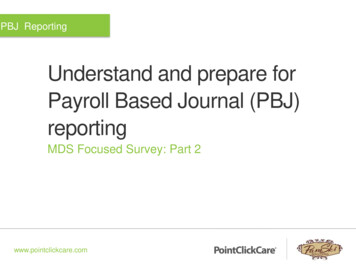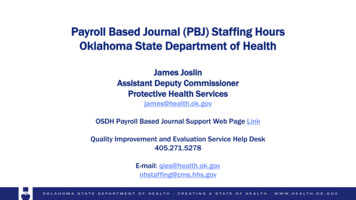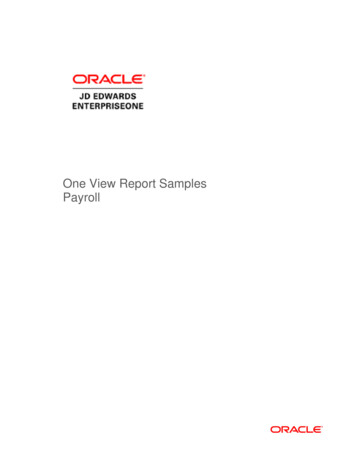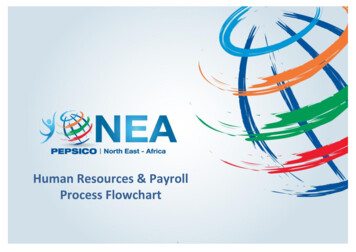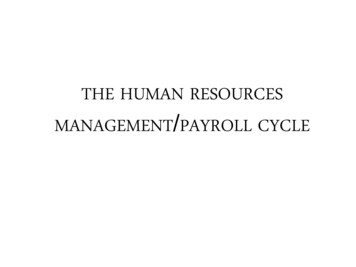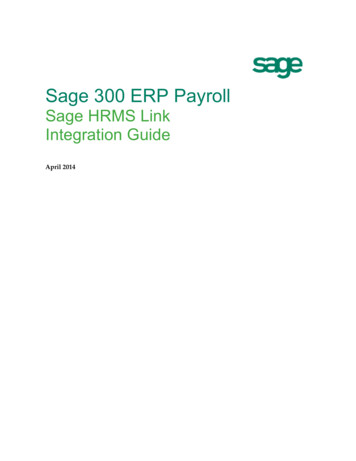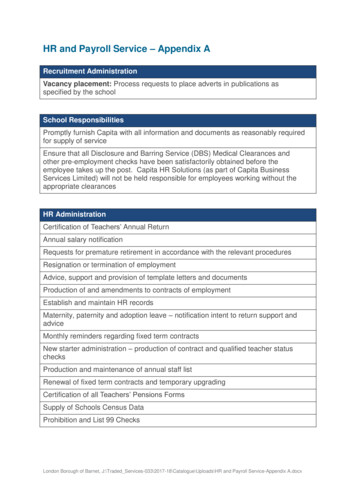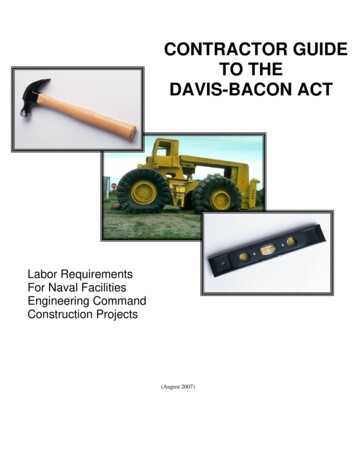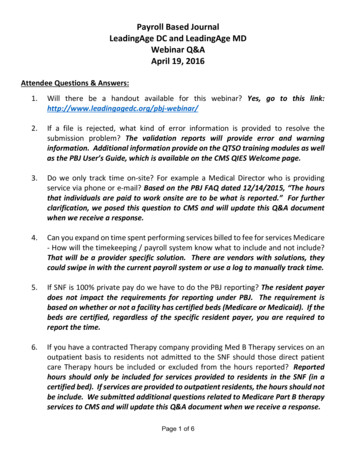
Transcription
W HI T E PA PERPayroll-Based Journal (PBJ) Reporting for Long-Term Care FacilitiesPayroll-Based Journal (PBJ)Reporting for Long-TermCare FacilitiesUnderstanding RequirementsSummaryEffective July 2016, long-term care (LTC) facilities are now required to report staffingand census information quarterly through a new software application, Payroll-BasedJournal (PBJ).While census information remains straightforward, facilities will need to accountfor the daily activities of every direct care worker, including job duties and hoursworked—a time-consuming administrative task for resource-strapped LTC facilities.To raise the stakes, the Centers for Medicare and Medicaid Services note that theyplan to audit data submissions and take noncompliance action on facilities providinginaccurate information.PBJ offers two ways to submit staffing information: manual entry (time-intensiveand error-prone) and data upload. Data upload, which entails generating a file froma payroll or time and attendance system and uploading it to PBJ, is the optimalchoice. Rather than relying on a payroll system that translates time and attendanceinformation into pay, ensure a seamless process with a time and attendance systemconfigured to output PBJ-compatible data files and offer both employees andmanagers the ability to ensure time and attendance information is captured in anaccurate and timely manner.www.attendanceondemand.com 2016 Attendance on Demand, Inc. All rights reserved.page 1
W HI T E PA PERPayroll-Based Journal (PBJ) Reporting for Long-Term Care FacilitiesACA Requires New Staffing Informationfor Long-Term CareThere’s no question about it—the Affordable Care Act has changed the gamefor employers, workers, even entire industries. And long-term healthcare is noexception.Effective July 1, 2016, all LTCfacilities are required to submitstaffing data for all workersthrough the Payroll-Based Journal.According to Section 6106 of the Affordable Care Act, longterm care (LTC) facilities will be required to electronicallysubmit direct care staffing information to the Centers forMedicare and Medicaid Services (CMS) through its newsoftware application, the Payroll-Based Journal (PBJ).1Effective July 1, 2016, all LTC facilities are required to submitstaffing information for all direct care workers (includingagency and contract employees) including hire date, pay type, work type and hoursworked each day at a specific job.2 Until then, LTC facilities can use PBJ to reporthours on a voluntary basis.And accuracy is crucial as CMS makes clear that it will “conduct audits to accessa facility’s compliance” in submitting correct information, noting, “Facilities thatdo not meet these requirements will be considered noncompliant and subject toenforcement actions by CMS.”3Staffing and Census Data to be Submitted Quarterlythrough PBJAs LTC facilities know, the Centers for Medicare and Medicaid Services (CMS)have been collecting census data as a way to gauge and compare quality of careamong facilities.Under ACA, facilities are now required to electronically submit daily staffing andmonthly census data each fiscal quarter through PBJ. Access to PBJ is free andfacilities can connect to the application through the Quality Improvement andEvaluation System (QIES) with a valid CMSnet user ID.Fiscal QuarterDates1Oct 1 – Dec 312Jan 1 – Mar 313Apr 1 – Jun 304July 1 – Sep 30Deadline for submissionsis the 45th day after thefinal date of each quarter at11:59 pm ET.While there is a hard deadline for each quarter, facilities can submit data multipletimes throughout the quarter. CMS will consider the last submission closest to thedeadline as the facility’s final submission. PBJ will continue to accept quarterlysubmissions after the deadline, but they will not be considered on time.4www.attendanceondemand.com 2016 Attendance on Demand, Inc. All rights reserved.page 2
W HI T E PA PERPayroll-Based Journal (PBJ) Reporting for Long-Term Care FacilitiesWhich Types of Data Will CMS Require?In addition to census data, CMS expects detailed accounts of each employee’sservice, including job title, services performed, and daily number of hours worked.See the sample PBJ entry screens below. More specifically, this informationincludes:Sample PBJ entry screen for employee information Employee ID – Facilities must assign each employee a uniqueID in PBJ. To protect privacy, PBJ will not accept or storeany identifiable personal employee information (such as nameor SSN). Hire Date – The first date the employee starts work (and willbe paid for services delivered). Termination Date – If applicable, the last date the employeeworked (and was paid for services delivered). Pay Type –Direct employee (exempt or non-exempt) orcontract staff. CMS defines contract staff as individualsworking under contract and individuals working at the facilitythrough a staffing agency. Hours Worked – Number of hours worked by the employee each day of thequarter. If the employee works more than one job at the facility, daily hoursneed to be separated out according to the services performed. Job Title and Labor Category Code –Employee’s job title(s) and servicesperformed according to a list of 40 CMS-defined job codes and descriptions.5,6In summary, CMS expects facilities to account for the daily activities of everyemployee—no small task for busy, admin-strapped LTC operations.How You Submit Data Can Make a DifferenceSo, how can facilities submit their data through PBJ? CMS identifies two ways: (1)manual entry or (2) data upload from an automated payroll or time and attendancesystem. Facilities can also use a combination of data upload and manual entry.Why You Should Avoid Manual EntryWhile CMS has prioritized PBJ’s interface as “intuitive” and “user-friendly,”manual entry is the most time-consuming and error-prone option. Whether enteredweekly, monthly, or all at once, inputting the daily hours and activities of everyemployee is a daunting task. Coupled with the specter of compliance enforcementactions if an audit reveals data has been entered incorrectly, most facilities shouldavoid this option whenever possible.Why Data Upload Is the Better OptionData upload from a time and attendance or payroll system offers several benefits.First, the data upload process will be similar to the way census information iscurrently submitted to CMS, so most facilities will be familiar with it.www.attendanceondemand.com 2016 Attendance on Demand, Inc. All rights reserved.page 3
W HI T E PA PERPayroll-Based Journal (PBJ) Reporting for Long-Term Care FacilitiesAlso, uploading data transfers information directly from onesystem (a time and attendance or payroll system) to another(PBJ) without interference. This eliminates keying or otherhuman errors associated with manual entry.Finally, data uploads save hours of time compared to manualinput—a key consideration for resource-strapped facilities.If data upload is clearly the best option, which system can saveyou more time and prevent accidental data errors?The Value of a Time and Attendance SystemWhile it’s possible for some payroll systems to provide theinformation CMS requires (others do not track daily hours), atime and attendance system is a better fit due to its functionality and purpose.Sample PBJ entry screen for staffing hoursBy design, a time and attendance system captures—andreports on—time and attendance information, such as hoursworked at specific jobs and employee status (full- or part-time,exempt or non-exempt). Payroll is designed only to mirrortime and attendance information by translating it into payand may not be configured to accurately report on this type ofinformation.To minimize erroneous data, the best policy is to go straight to the source—in thiscase, by utilizing a time and attendance system.What to Look For in a Time and Attendance SystemWhile a time and attendance system is a better solution for quarterly PBJ uploads,certain features will help ensure the process is seamless and error-free. Data upload files that meet PBJ’s data submission specifications. PBJhas detailed specific technical specifications a data file must meet in order tobe submitted successfully. It is crucial to ensure your time and attendancesystem will create files that meet these specifications to avoid a future ofmanual entry. Ability for employees to enter and/or approve their hours. To meet CMScriteria, time and attendance should reflect actual hours worked, not scheduled hours. Because employees are the most accurate source of their time andattendance information, a time and attendance system that allows employeesto punch in or enter their hours (through a Web browser, mobile app or timeclock) and approve their time card creates a solid foundation of accurate timeand attendance information. Access for managers to edit and change hours. Managers also need theability to edit employee hours, whether in the event of sick leave, a shiftchange, or a missed punch. (Ensure that the system will track and log anychanges for verification, if necessary.) Giving access to both managers andemployees provides a checks-and-balances system to keep time and attendancedata accurate and timely.www.attendanceondemand.com 2016 Attendance on Demand, Inc. All rights reserved.page 4
W HI T E PA PERPayroll-Based Journal (PBJ) Reporting for Long-Term Care FacilitiesConclusionEffective July 2016, all LTC facilities are now required to provide quarterlystaffing and census information to CMS. Rather than opting for error-pronemanual entry, facilities are wise to choose data upload through a time and attendance system because it is the most reliable way to submit information. The righttime and attendance system will meet PBJ’s technical specifications for successfulsubmission for data upload and encourage accurate data capture with bothemployee and manager access.ABOUT ATTENDANCE ON DEMAND, INC.Attendance on Demand supports the labor management needs of thousands ofcompanies and nearly one million employees across North America. Launchedin 2006, Attendance on Demand is a rapidly deployed, cloud-based solution thatminimizes a company’s risk and technology investment while providing advancedfeatures for securely managing labor data—calculating pay rules, schedulingemployees, budgeting labor, automating recordkeeping for labor law complianceand managing employee status and reporting for the Affordable Care Act. Withstandard uptime over the industry average of 99.995% and above average customerretention rates, Attendance on Demand removes the worry of maintaining expensiveinfrastructure. An extensive North American distribution network helps organizations use Attendance on Demand to reduce labor expenses and improve decisionmaking.This document simplifies a complex Act as it is understood by Attendance on Demand, Inc. It is notto be taken as legal advice. For further information about ACA and CMS compliance, please visitthe Centers for Medicare and Medicaid Services at www.cms.gov.References1 Centers for Medicare and Medicaid Services. “Implementation of Section 6106 of the AffordableCare Act – Collection of Staffing Data for Long Term Care Facilities.” CMS.gov. 10 Apr 2015. Web.Accessed 8 Jun 2015. ds/Survey-and-Cert-Letter-15-35.pdf2 Interested facilities can apply now to begin submitting this information voluntarily through PBJ.3 Centers for Medicare and Medicaid Services. “Electronic Staffing Data Submission Payroll-BasedJournal, Long-Term Care Facility Policy Manual, Version 1.1.” CMS.gov. Aug 2015. Web its/Downloads/PBJ-Policy-Manual-Draft-V11.pdf4 Ibid.5 The list of job codes and descriptions can be found in Table 1 (pages 2-5 to 2-9) at ts/Downloads/PBJ-Policy-Manual-Draft.pdf.6 Centers for Medicare and Medicaid Services. “Electronic Staffing Data Submission Payroll-BasedJournal, Long-Term Care Facility Policy Manual, Version 1.0.”To find out howAttendance on Demandcan help your organization,call 800-465-9980 or visitwww.attendanceondemand.comReady to learn more?Contact us today »www.attendanceondemand.com 2016 Attendance on Demand, Inc. All rights reserved.Attendance on Demand is a registered trademark of Attendance on Demand, Inc.page 501/16 rev. 07/16
software application, the Payroll-Based Journal (PBJ).1 Effective July 1, 2016, all LTC facilities are required to submit staffing information for all direct care workers (including agency and contract employees) including hire date, pay type, work type and hours worked each day at a specific job.2 Until then, LTC facilities can use PBJ to report
